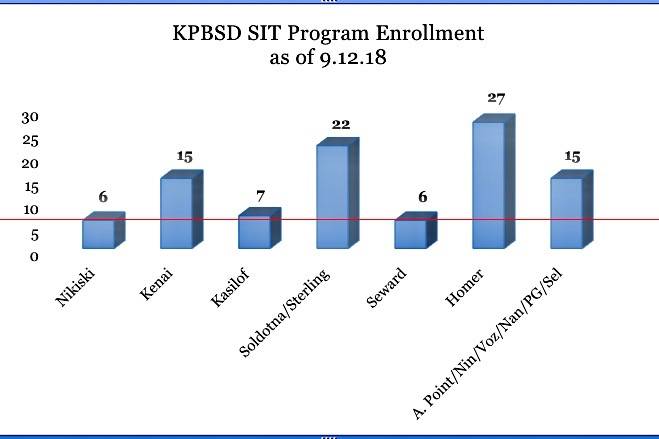The Kenai Peninsula Borough School District has seen a 42-percent increase in their Students in Transition program from this time last year. The 16-year-old program provides services to homeless students and students no longer in the custody of their parent or legal guardian.
As of Sept. 12, there have been 98 students referred to the program. There were 69 students identified at this time last year.
“These are only the students we know of, not necessarily all the homeless students present within our District,” Kelly King, the district’s Students in Transition coordinator, said. “We work very hard to identify and support as many as we can, but we know there are more that we aren’t aware of, for a variety of reasons.”
King has been the coordinator for nearly 11 years, and works with Jane Dunn, a liaison in Homer who serves the southern peninsula.
“Our job is to identify homeless students within the school district,” King said.
Referrals come from a variety of places, including students, parents and school staff. When a student is referred, King does a needs assessment to make sure the child qualifies for the federal definition of homelessness. After a student is enrolled, they are enrolled for the entire school year. Youth enrolled in the program must be attending school. Needs relating to school attendance are addressed by the program, including school supplies, hygiene products, free meals, transportation to and from school and all of those things that can be a big stressor for a family when they’re housing situation is vulnerable, King said.
“Our whole goal is to make sure students have access to education and that they can have everything they need to succeed while they are there,” King said.
Enrollment in the program is always high at the beginning of the year. However, King said she couldn’t attribute any one thing to the rise in enrollment this year, compared to last year. There is no carrying over from one year to the next — each student must re-enter the program every year.
“Are staff and teachers getting better at identifying students?” Pegge Erkeneff, the district’s communications liaison, said. “Kelly said ‘no,’ it’s nothing specific.”
Erkeneff said the spike in enrollment is interesting because of the nicer fall weather the area has been experiencing.
“We always see a spike when the weather gets cold,” Erkeneff said. “So, in the fall when it gets colder, numbers jump. Or as soon as we have our first big cold spells in October and November, we’ll see a spike. But now, it’s warm. The weather is nice. For people who are tent camping, the weather isn’t affecting them that much, yet.”
King said families will often do the best they can until the cold hits, after which those families tend to reach out to available resources.
Enrollment will continue to grow all the way until the last day of school. On average, the program serves around 250 students per year.
“Even if a student becomes permanently housed, the chances of them becoming homeless again are very high, “ King said. “We really try to follow with the support and services for the entire year.”
King said the central peninsula is one of the only communities of its size that does not have a family or youth shelter in place.
“We’re not driving by those facilities on the Kenai, because they don’t exist,” King said. “It takes our attention away from an issue that is actually happening. Bringing awareness that homelessness is even a problem in our community is huge because it’s rather invisible.”
Homelessness within the district is spread out. In areas with a larger population like Homer and Soldotna, more students are enrolled in the program.
In Nikiski, there are six students enrolled in the Students in Transition program. In Kenai, that number is more than double, with 15 enrolled. Seven Kasilof students are enrolled in the program. In Soldotna and Sterling, there are 22 students enrolled. Six Seward students are enrolled in the program. Homer has 27 students enrolled, and the combined area of Anchor Point, Ninilchik, Nanwalek, Port Graham and Seldovia has 15 students enrolled in the program.
The district used to hold a vigil for homelessness to bring awareness to the issue. One year, an anonymous donor donated $10,000 to the program, Erkeneff said.
People who are interested in donating to the program can help in two ways. There is a donations account set up for the program that becomes useful after grants run out, which King said is usually around Christmas. Another way is to support the agencies that support the children outside of the district like the Kenai Peninsula Food Bank, Love INC, and the LeeShore Center.
King said students and families become homeless for a variety of reasons, including domestic violence, natural disaster, illness or disease and little-to-no health insurance, lack of affordable housing within a community, divorce or death in a family, substance abuse or mental health disorders, loss of a job or lack of employment or abandonment.
“There is no single reason why people experience homelessness, despite certain stereotypes that are often presented,” King said.
Reach Victoria Petersen at vpetersen@peninsulaclarion.com.

